Breast Cancer Drugs Market Research, 2032
The global breast cancer drugs market size was valued at $26.4 billion in 2022, and is projected to reach $59.3 billion by 2032, growing at a CAGR of 8.4% from 2023 to 2032. Breast cancer is a malignant tumor that originates in breast tissue. It is the most commonly diagnosed cancer in women globally, and it also affects a smaller percentage of men. Breast cancer occurs when abnormal cells in the breast divide and grow uncontrollably, forming a tumor that can invade surrounding tissues or spread to other parts of the body. The treatment of breast cancer involves a multidisciplinary approach, which includes chemotherapy and hormonal therapy. However, recent advancements in the understanding of the molecular mechanisms underlying breast cancer have led to the development of targeted therapies and immunotherapies. These innovative treatments aim to specifically target the cancer cells while minimizing the side effects on healthy tissues.
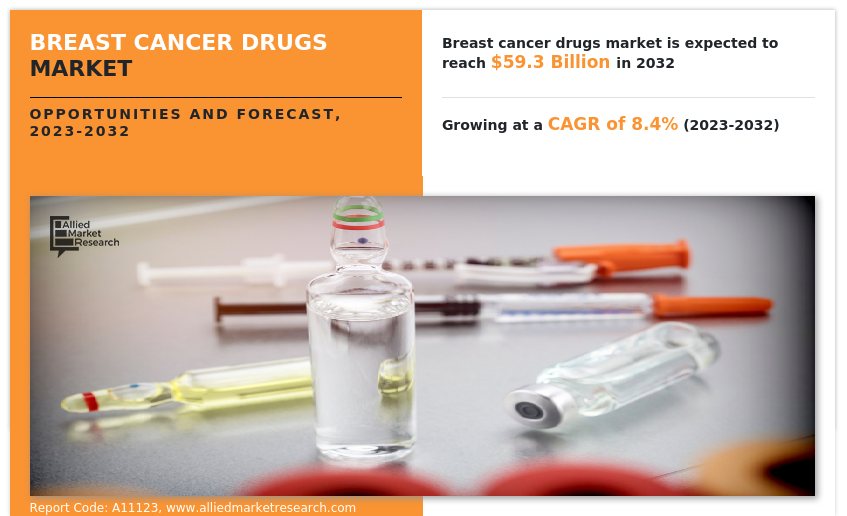
Key Market Dynamics
The major factors driving the growth of breast cancer drugs market are increasing prevalence of breast cancer, awareness regarding early diagnosis and adoption of novel treatment options for breast cancer. The increasing prevalence of risk factors such as aging population, genetic mutations, hormonal factors, and lifestyle changes contributes to the growing number of breast cancer cases. As the number of diagnosed patients continues to rise, there is a corresponding demand for effective drugs and treatment options, driving the market growth.
Further, technological advancements in breast cancer diagnostics and imaging have had a significant impact on the drugs market. Innovations in mammography, magnetic resonance imaging (MRI), and molecular imaging techniques enable early detection, accurate diagnosis, and monitoring of treatment response. These advancements facilitate the selection of appropriate drugs and treatment modalities, driving breast cancer drugs market growth.
In addition, significant advancements in breast cancer research and development have fueled the growth of the drugs market. Ongoing research efforts have led to a better understanding of the molecular mechanisms underlying breast cancer, identification of novel targets, and the development of innovative drugs. Technological advancements, such as genomics, proteomics, and high-throughput screening techniques, have facilitated the discovery and development of targeted therapies and personalized medicine approaches.
Further, rise in adoption of targeted therapies, which specifically target molecules and pathways involved in breast cancer progression, have become a cornerstone of treatment. Drugs such as trastuzumab, pertuzumab, and CDK4/6 inhibitors have shown significant efficacy in specific breast cancer subtypes. In addition, immunotherapies, such as immune checkpoint inhibitors, have shown promise in subsets of breast cancer patients by harnessing the body's immune system to fight cancer cells. The development and approval of these targeted therapies and immunotherapies have expanded treatment options and contributed to market growth.
Moreover, government initiatives aimed at breast cancer awareness, screening, and access to healthcare have positively influenced the breast cancer drugs market. Supportive policies, such as the implementation of national breast cancer screening programs, investment in research and development, and the provision of subsidies for breast cancer drugs, create a conducive environment for market growth.
The growth of the breast cancer drugs market is expected to be driven by emerging markets, owing to availability of improved healthcare infrastructure, increase in unmet healthcare needs, rise in prevalence of cancer cases, and surge in demand for novel drugs for management of breast cancer. Furthermore, the healthcare industry in emerging economies is developing at a significant rate, owing to rise in demand for enhanced healthcare services, significant investments by government to improve healthcare infrastructure, and development of the medical tourism industry in emerging countries.
Various organizations along with the government are counselling people regarding cancer and available treatment options. E-commerce (electronic commerce) has become a vital tool for small and large businesses globally, owing to a rise in preference of consumers for online shopping over traditional purchasing methods. Various animations through health apps to educate people regarding breast cancer and usage of medications have contributed toward the growth of breast cancer drugs industry.
The demand for effective targeted therapy and monoclonal antibodies is not only limited to developed countries but is also being witnessed in the developing countries, such as China, Brazil, and India, which fuel the growth of the market. Moreover, an increase in promotional activities by manufacturers and growth in awareness for proper treatment medications for breast cancer among the general population is expected to fuel their adoption in the near future.
However, breast cancer drugs, particularly chemotherapy, can cause significant side effects and toxicity. These adverse effects can impact patients' quality of life, lead to treatment discontinuation, and require additional supportive care. The tolerability and toxicity profile of drugs influence treatment decisions and patient adherence, posing challenges in optimizing treatment outcomes while minimizing side effects.
The outbreak of COVID-19 has disrupted workflows in the health care sector around the world. The pandemic has disrupted healthcare services globally, with a shift in resources and focus towards managing COVID-19 patients. Non-urgent medical procedures, including cancer screenings and treatments, have been delayed or canceled, leading to a decline in breast cancer diagnoses and subsequent treatment initiation. This disruption has affected the demand for breast cancer drugs and created challenges in patient management.
Further, fear of contracting the virus and restrictions on movement have resulted in reduced patient visits to healthcare facilities. This has impacted patient adherence to treatment regimens, including breast cancer drugs. Interruptions in treatment and non-adherence can compromise treatment outcomes and increase the risk of disease progression.
Moreover, pandemic has caused disruptions in global supply chains, including the pharmaceutical industry. Manufacturing facilities, transportation networks, and logistics have been affected, leading to potential shortages or delays in the production and distribution of breast cancer drugs. Supply chain disruptions have impacted drug availability and posed challenges in meeting the demand for essential medications. Thus, COVID-19 negatively impacted to the growth of breast cancer drugs market.
However, as healthcare systems regain stability, efforts to recover and resume non-urgent medical services, including breast cancer screenings, diagnoses and treatments. This recovery phase is expected to lead to an increased demand for breast cancer drugs as the backlog of postponed procedures is addressed. Healthcare providers will focus on ensuring timely access to care and treatment to mitigate the impact of delayed diagnoses and treatment initiation.
In addition, efforts to promote breast cancer screenings and awareness campaigns are expected to drive the market growth. Governments, healthcare organizations, and advocacy groups may invest in initiatives to encourage individuals to undergo regular screenings, leading to earlier detection of breast cancer cases. This emphasis on early detection will contribute to an increased demand for breast cancer drugs.
Market Segmentation
The global breast cancer drugs market is segmented into therapy, age group, distribution channel and region. On the basis of therapy, the market is categorized into chemotherapy, hormonal therapy, targeted therapy and immunotherapy. On the basis of age group, the market is categorized into below 55 years, and above 55 years. On the basis of distribution channel, the market is segregated into hospital pharmacies, drug stores and retail pharmacies and online providers. Region wise, the market is analyzed across North America (the U.S., Canada, and Mexico), Europe (Germany, France, the UK, Italy, Spain, and rest of Europe), Asia-Pacific (Japan, China, Australia, India, South Korea, and rest of Asia-Pacific), and LAMEA (Brazil, South Africa, Saudi Arabia, and rest of LAMEA).
By Therapy
The targeted therapy segment accounted for largest breast cancer drugs market share in 2022, owing to a rise in adoption of targeted therapy in breast cancer treatment. In addition, recent advances in cellular technology have contributed to improving the understanding of tumor cells and their metabolism at molecular level, thus driving the need for targeted drug therapies for cancer treatment. On the other hand, hormonal therapy is expected to witness highest CAGR during the forecast period owing to proven efficacy of hormonal therapy in hormone receptor-positive breast cancer cases and wide availability of hormonal drugs for breast cancer treatment.
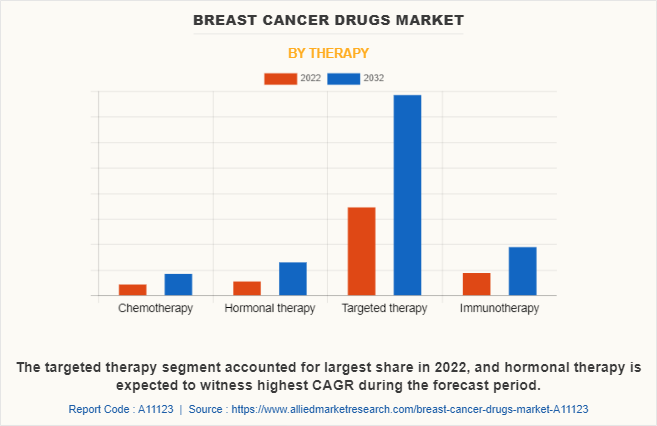
By Age Group
The above 55 years segment accounted for largest breast cancer drugs market share in 2022 and is expected to register highest CAGR during forecast period owing to rise in number of breast cancer cases diagnosed in this age group.
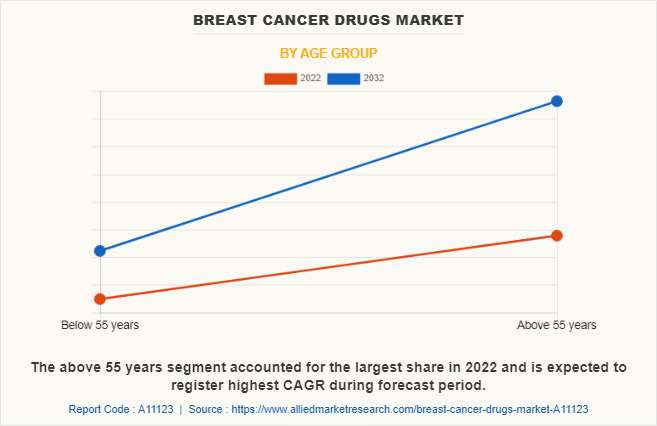
By Distribution Channel
The drug stores and retail pharmacies segment accounted for largest breast cancer drugs market size in 2022, owing to accessibility of retail pharmacies everywhere and large chain of distribution networks. In addition, drug stores and retail pharmacies play an important role in providing education and counseling to patients about their medications, potential side effects, and the importance of adhering to their treatment plans. The online providers segment is projected to register the highest CAGR during the breast cancer drugs market forecast period owing to the rise in popularity of online pharmacy and number of users preferring online pharmacies.
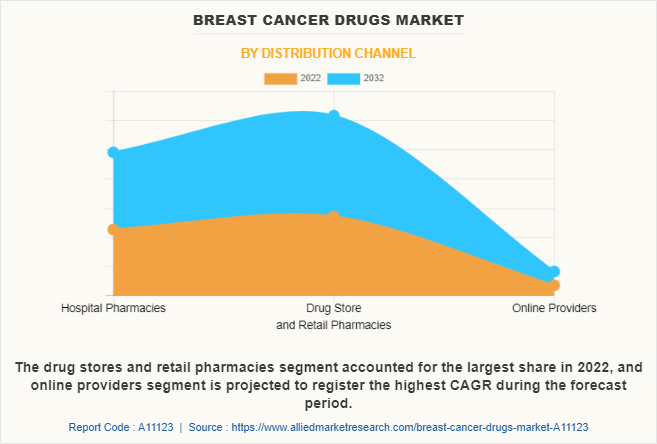
Regional/Country Market Outlook
The breast cancer drugs market size is analyzed across North America, Europe, Asia-Pacific, and LAMEA. North America accounted for largest share in 2022 and is expected to remain dominant during the forecast period owing to presence of large patient population suffering from breast cancer, strong presence of key players, ease of drug availability, well developed healthcare infrastructure, favorable reimbursement policies in healthcare system, higher number of research, development, & innovation activities and higher adoption of advanced therapeutics for breast cancer. However, Asia-Pacific is anticipated to witness notable growth, owing to increase in investments for development of anti-cancer agents, increase in number of breast cancer cases and rise in awareness related to available treatment options, thereby driving the growth of market during the forecast period.
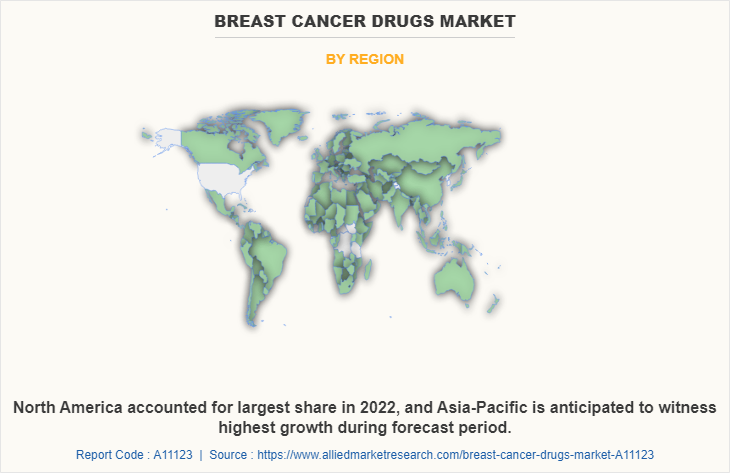
Presence of several major players, such as F. Hoffmann-La Roche Ltd., Novartis AG, Pfizer Inc., AstraZeneca, Eli Lilly and Company, Merck & Co., Inc., and advancement in manufacturing technology for development of effective treatment options for breast cancer in the region is expected to drive the growth of breast cancer drugs market. In addition, various private organizations organize educating camps for awareness of cancer and treatment options available across the globe is expected to drive growth of this market. Furthermore, the presence of well-established healthcare infrastructure and rise in adoption rate of new treatment options such as targeted therapy for breast cancer is expected to drive the market growth.
Asia-Pacific is expected to grow at the highest rate during the forecast period. The breast cancer drugs market growth in this region is attributable to the presence of key players in the region. The Asia Pacific region has made significant efforts in improving its healthcare infrastructure, including cancer care facilities and specialized oncology centers. The establishment of comprehensive cancer centers, advancements in diagnostic technologies, and access to modern treatment modalities have positively impacted the breast cancer drugs industry. Improved healthcare infrastructure enables timely diagnosis, effective treatment, and access to a wide range of breast cancer drugs, drive the market growth.
Asia-Pacific offers profitable breast cancer drugs market opportunity for key players operating in the breast cancer drugs market, thereby registering the fastest growth rate during the forecast period, owing to the growing infrastructure of industries, rising in spending for cancer research, as well as well-established presence of domestic companies in the region. In addition, the rise in contract manufacturing organizations within the region provides great opportunity for new entrants in this region.
Competitive Landscape
Competitive analysis and profiles of the major players in the breast cancer drugs market, such as Novartis AG, Pfizer Inc., AstraZeneca, Eli Lilly and Company, Merck & Co., Inc., Bristol-Myers Squibb Company, Viatris Inc., Zydus Lifesciences Limited, Teva Pharmaceutical Industries Ltd., and F. Hoffmann-La Roche Ltd. Major players have adopted product approval, expansion, and agreement as key developmental strategies to improve the product portfolio of the breast cancer drugs industry.
Recent Product Approvals in Breast Cancer Drugs Market
In October 2021, U.S. Food and Drug Administration (FDA) has approved Eli Lilly and Company's Verzenio (abemaciclib), in combination with endocrine therapy (tamoxifen or an aromatase inhibitor), for the adjuvant treatment of adult patients with hormone receptor-positive (HR+), human epidermal growth factor receptor 2-negative (HER2-), node-positive, early breast cancer (EBC) at high risk of recurrence.
In July 2021, Merck, known as MSD outside the United States and Canada, announced that the U.S. Food and Drug Administration (FDA) has approved KEYTRUDA, Merck’s anti-PD-1 therapy, for the treatment of patients with high-risk early-stage triple-negative breast cancer (TNBC) in combination with chemotherapy as neoadjuvant treatment and then continued as a single agent as adjuvant treatment after surgery, based on the Phase 3 KEYNOTE-522 trial.
Key Benefits for Stakeholders
- This report provides a quantitative analysis of the market segments, current trends, estimations, and dynamics of the breast cancer drugs market analysis from 2022 to 2032 to identify the prevailing breast cancer drugs market opportunities.
- The market research is offered along with information related to key drivers, restraints, and opportunities.
- Porter's five forces analysis highlights the potency of buyers and suppliers to enable stakeholders make profit-oriented business decisions and strengthen their supplier-buyer network.
- In-depth analysis of the breast cancer drugs market segmentation assists to determine the prevailing market opportunities.
- Major countries in each region are mapped according to their revenue contribution to the global breast cancer drugs market.
- Market player positioning facilitates benchmarking and provides a clear understanding of the present position of the breast cancer drugs market players.
- The report includes the analysis of the regional as well as global breast cancer drugs market trends, key players, market segments, application areas, and market growth strategies.
Breast Cancer Drugs Market Report Highlights
| Aspects | Details |
| Market Size By 2032 | USD 59.3 billion |
| Growth Rate | CAGR of 8.4% |
| Forecast period | 2022 - 2032 |
| Report Pages | 252 |
| By Therapy |
|
| By Age group |
|
| By Distribution channel |
|
| By Region |
|
| Key Market Players | Novartis AG, Gilead Sciences, Inc., Eli Lilly and Company, Merck & Co., Inc., AstraZeneca plc, Pfizer Inc., Bristol-Myers Squibb Company, F. Hoffmann-La Roche Ltd., Teva Pharmaceutical Industries Ltd., Zydus Lifesciences Limited |
| Other Players | AstraZeneca Plc |
Analyst Review
This section provides various opinions in the global breast cancer drugs market. The global breast cancer drugs market is expected to grow owing to, increase in demand for novel drugs and rise in investments for development of therapeutic agents for breast cancer globally offering profitable opportunities for the expansion of the market. In addition, favorable government initiatives and higher spending for breast cancer, have piqued the interest of several companies to develop breast cancer drugs.
Further increase in adoption of targeted drug therapy for breast cancer owing to enhanced efficacy, improved survival rates, and reduced toxicity as compared to conventional chemotherapy is expected to boost the growth of market. In addition, personalized medicine approaches, based on individual patient characteristics and tumor profiling, are gaining prominence in breast cancer treatment.
Furthermore, North America accounted for the largest share in 2022 and is expected to remain dominant during the forecast period owing to presence of large patient population suffering from breast cancer, strong presence of key players, favorable reimbursement policies in healthcare system, and higher adoption of advanced therapeutics for breast cancer. However, Asia-Pacific is anticipated to witness notable growth owing to increase in investments for development of anti-cancer agents, surge in number of breast cancer cases, and rise in awareness related to available treatment options, thereby driving the growth of market during the forecast period.
The total market value of breast cancer drugs market is $26,405.96 million in 2022.
The forecast period for breast cancer drugs market is 2023 to 2032.
The market value of breast cancer drugs market in 2032 is $59,324.30 million.
The base year is 2022 in breast cancer drugs market.
Top companies such as, F. Hoffmann-La Roche Ltd., Novartis AG, Pfizer Inc., AstraZeneca, Eli Lilly and Company, and Merck & Co., Inc., held a high market position in 2022. These key players held a high market position owing to the strong geographical foothold in North America, Europe, Asia-Pacific, and LAMEA.
The targeted therapy segment is the most influencing segment in breast cancer drugs market owing to a rise in adoption of targeted therapy in breast cancer treatment. In addition, recent advances in cellular technology have contributed to improving the understanding of tumor cells and their metabolism at molecular level, thus driving the need for targeted drug therapies for cancer treatment.
The major factors driving the growth of breast cancer drugs market are increasing prevalence of breast cancer, awareness regarding early diagnosis and adoption of novel treatment options for breast cancer.
Breast cancer forms in the cells of the breast. It is the most common cancer among women worldwide and can affect men, although it is less common.
Treatment for breast cancer typically involves a combination of approaches, including chemotherapy, hormonal therapy, and targeted therapy.
Loading Table Of Content...
Loading Research Methodology...



